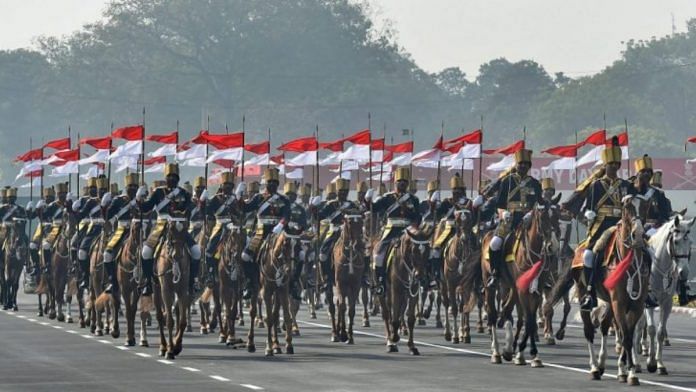New Delhi: One of the world’s last remaining horse-mounted regiments — the 61 Cavalry — prominently known for its ceremonial and equestrian roles is set to be converted into a full-fledged armoured regiment.
The Army has reportedly initiated a move to mechanise the Jaipur-based cavalry regiment and create a new armoured regiment. It plans to bring together three independent squadrons of other regiments across the country under the headquarters of 61st Cavalry to form the new regiment. The regiment has around 300 horses.
The move is being initiated to cut costs and draws from a proposal to change the regiment’s role to an active armoured regiment based on the recommendations of the 2016 Shekatkar Committee report.
The committee was set up to suggest ways to enhance combat capability and re-balance defence expenditure of the armed forces.
“The regiment was supposed to have one squadron capable of handling tanks, T-55, the last I’d heard, and may have done that, or form a part of an Armoured Delivery Regiment that holds immediate replacements of tanks for fighting units after mobilisation for Operation Parakram,” Major General Birender Dhanoa (retired), an Armoured Corps veteran, told ThePrint.
Operation Parakram was a military standoff between India and Pakistan that began in January 2002 in the wake of the terrorist attack in the Parliament in December 2001.
“… as of now, the regiment headquarters will form the nucleus for the armoured unit, probably to be called 61 Cavalry only, while the horses will be moved to Delhi to be an independent unit for equestrian and ceremonial duties,” he said.
Besides the 61st Cavalry, the President’s Bodyguards — which purely performs ceremonial roles for the President of India — is the only other mounted regiment in the Army.
Also read: Lt Gen. Hanut Singh — bold commander who led from front in 1971, but was never made Army chief
Its history
The 61st Cavalry was formed immediately after India’s independence in 1947 following the amalgamation of the princely states with India. All regular and irregular erstwhile state forces’ cavalry units were disbanded to raise a new Horse Cavalry Regiment.
In 1954, the Gwalior Lancers, Jodhpur/Kachhawa Horse and Mysore Lancers, which were the cavalry regiments, were merged to form the 61st Cavalry.
Over the years, the regiment has performed ceremonial, equestrian as well as operational roles.
The regiment also participated in the battle of Haifa in Israel. Haifa Day is celebrated every year on 23 September to pay tribute to the Indian cavalry regiments of Mysore, Hyderabad and Jodhpur, which helped liberate Haifa in 1918.
The decorated regiment has also earned a Padma Shri, 11 Arjuna Awards, 9 Asian Games medals, a gold medal in Polo World Cup against Pakistan, silver in Jakarta Asian Games, among other accolades in equestrian sports.
“The regiment is a symbol of India’s heritage,” Colonel Atul Gupta (retired), who has served in the regiment, told ThePrint.
“61st Cavalry plays an important ceremonial and sports role. It has been leading the contingents during the Republic Day parade and plays a significant role in the Independence Day function and the Beating Retreat ceremony. It has been at the forefront at the equestrian and polo field,” he said.
“But, on several occasions, the regiment has been deployed for critical operational roles,” he said.
Role in Operation Parakram
Officers who have served in the 61st Cavalry said in the late 1990s and early 2000s, some armoured vehicles were initially given to the regiment, which were returned on account of being obsolete.
“Then the regiment was given the role of security of vital areas and points, which included the defence of IAF airfields in the western sector, where the regiment was deployed on ground as foot soldiers,” an officer said.
“During Operation Parakram, the regiment was deployed on the western border for the entire duration of the operation in defence of vital installations,” the officer added.
‘Shock to the system’
The move has, however, drawn criticism from Army veterans.
A former Army officer, who didn’t want to be named, told ThePrint that purely from a book-keeping point of view, there will be some “minuscule” revenue savings.
“But to the Army, especially the traditional bunch, it is a shock to the system. If the horses are being retained, then what is the big deal of having keeping them as a part of the original 61st Cavalry itself,” he asked.
“It is hitting at military tradition, pomp and ceremony, which is integral to esprit de corps. An unstated issue is the prime estate the unit occupies in Jaipur,” he added.
Some said it is also difficult to justify the fact that 61st Cavalry will no longer retain its heritage building and the regiment will be shifted out.
Colonel Gupta told ThePrint the move will likely affect the regiment’s sports capabilities.
“There are hardly any new officers, so participation will reduce as polo, as a sport, requires a lot of effort, time, manpower and dedication. The regiment may just be reduced to a symbolic unit with no wherewithal to continue being the custodian of the equestrian sports in the country,” he said.
Army chief General M.M. Naravane is the colonel of the regiment.
Gupta said: “Hopefully, the commandant of the regiment will be able to convince him (Naravane) of the regiment’s relevance.”
Also read: 5 heroes of 1971 Bangladesh Liberation War who led India to decisive win over Pakistan







Jai Hind jay Bharat
Jay hind